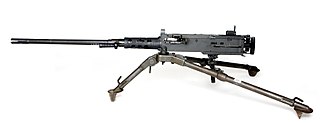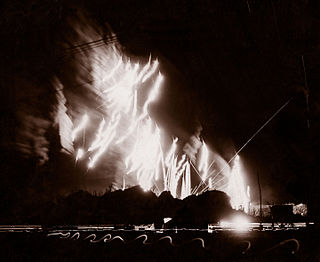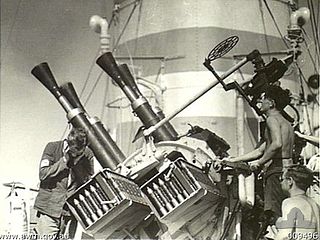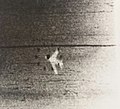
A machine gun is a fully automatic, rifled auto-loading firearm designed for sustained direct fire with rifle cartridges. Other automatic firearms such as automatic shotguns and automatic rifles are typically designed more for firing short bursts rather than continuous firepower and are not considered true machine guns. Submachine guns fire handgun cartridges rather than rifle cartridges, therefore they are not considered machine guns, while automatic firearms of 20 mm (0.79 in) caliber or more are classified as autocannons rather than machine guns.

The M61 Vulcan is a hydraulically, electrically, or pneumatically driven, six-barrel, air-cooled, electrically fired Gatling-style rotary cannon which fires 20 mm × 102 mm rounds at an extremely high rate. The M61 and its derivatives have been the principal cannon armament of United States military fixed-wing aircraft for over sixty years.

Anti-aircraft warfare, counter-air, anti-air, AA guns, layered air defence or air defence forces is the battlespace response to aerial warfare, defined by NATO as "all measures designed to nullify or reduce the effectiveness of hostile air action". It includes surface based, subsurface, and air-based weapon systems, associated sensor systems, command and control arrangements, and passive measures. It may be used to protect naval, ground, and air forces in any location. However, for most countries, the main effort has tended to be homeland defence. NATO refers to airborne air defence as counter-air and naval air defence as anti-aircraft warfare. Missile defence is an extension of air defence, as are initiatives to adapt air defence to the task of intercepting any projectile in flight.

The M2 machine gun or Browning .50 caliber machine gun is a heavy machine gun that was designed near the end of World War I by John Browning. While similar to Browning's earlier M1919 Browning machine gun, which was chambered for the .30-06 cartridge, the M2 uses Browning's larger and more powerful .50 BMG cartridge. The design has had many designations; the official U.S. military designation for the infantry type is Browning Machine Gun, Cal. .50, M2, HB, Flexible. It is effective against infantry, unarmored or lightly armored vehicles and boats, light fortifications, and low-flying aircraft.

The .50 Browning Machine Gun is a .50 in (12.7 mm) caliber cartridge developed for the M2 Browning heavy machine gun in the late 1910s, entering official service in 1921. Under STANAG 4383, it is a standard service cartridge for NATO forces as well as many non-NATO countries. The cartridge itself has been made in many variants: multiple generations of regular ball, tracer, armor-piercing (AP), incendiary, and saboted sub-caliber rounds. The rounds intended for machine guns are made into a continuous belt using metallic links.

An autocannon, automatic cannon or machine cannon is a fully automatic gun that is capable of rapid-firing large-caliber armour-piercing, explosive or incendiary shells, as opposed to the smaller-caliber kinetic projectiles (bullets) fired by a machine gun. Autocannons have a longer effective range and greater terminal performance than machine guns, due to the use of larger/heavier munitions, but are usually smaller than tank guns, howitzers, field guns, or other artillery. When used on its own, the word "autocannon" typically indicates a non-rotary weapon with a single barrel. When multiple rotating barrels are involved, such a weapon is referred to as a "rotary autocannon" or occasionally "rotary cannon", for short.

Tracer ammunition (AMO) (Tracers) are bullets or cannon-caliber projectiles that are built with a small pyrotechnic charge in their base. When fired, the pyrotechnic composition is ignited by the burning powder and burns very brightly, making the projectile trajectory visible to the naked eye during daylight, and very bright during nighttime firing. This allows the shooter to visually trace the flight path of the projectile and thus make necessary ballistic corrections, without having to confirm projectile impacts and without even using the sights of the weapon. Tracer fire can also be used as a marking tool to signal other shooters to concentrate their fire on a particular target during battle.
The M60, officially the Machine Gun, Caliber 7.62 mm, M60, is a family of American general-purpose machine guns firing 7.62×51mm NATO cartridges from a disintegrating belt of M13 links. There are several types of ammunition approved for use in the M60, including ball, tracer, and armor-piercing rounds.
Rate of fire is the frequency at which a specific weapon can fire or launch its projectiles. This can be influenced by several factors, including operator training level, mechanical limitations, ammunition availability, and weapon condition. In modern weaponry, it is usually measured in rounds per minute or rounds per second.

The MG FF was a drum-fed, blowback-operated, 20 mm aircraft autocannon, developed in 1936 by Ikaria Werke Berlin of Germany. It was a derivative of the Swiss Oerlikon FF F cannon, with the Oerlikon FF design itself a development of the Imperial German World War I Becker 20 mm cannon, and was designed to be used in space-limited, fixed mountings such as inside aircraft wings, although it saw use as both an offensive and a defensive weapon, in both fixed and flexible format. It saw widespread use in those roles by the German Luftwaffe, particularly during the early stages of World War II, although from 1941 onwards it was gradually replaced by the Mauser firm's 20 mm MG 151/20, which was lighter, and had both a higher rate of fire and muzzle velocity.

The M242 Bushmaster chain gun is a 25 mm (25×137mm) single-barrel chain-driven autocannon. It is used extensively by the U.S. military, such as in the Bradley fighting vehicle, as well as by other NATO members and some other nations in ground combat vehicles and various watercraft. Hughes Helicopters in Culver City, California, was the original designer and manufacturer. McDonnell Douglas Helicopters acquired Hughes Helicopters in 1985, and merged into Boeing Corporation in 1997. In 2002, it was sold again to Alliant Techsystems, which merged with Orbital Sciences Corporation in 2015 to form Orbital Science ATK and was, in turn, bought out by Northrop Grumman in 2018. As of 2019, Northrop Grumman Innovation Systems produces the gun.

The 2-pounder gun, officially the QF 2-pounder and universally known as the pom-pom, was a 40 mm (1.6 in) British autocannon, used as an anti-aircraft gun by the Royal Navy. The name came from the sound that the original models make when firing. This QF 2-pounder was not the same gun as the Ordnance QF 2-pounder, used by the British Army as an anti-tank gun and a tank gun, although they both fired 2 lb (0.91 kg), 40 mm (1.6 in) projectiles.

A rotary cannon, rotary autocannon, rotary gun or Gatling cannon, is any large-caliber multiple-barreled automatic firearm that uses a Gatling-type rotating barrel assembly to deliver a sustained saturational direct fire at much greater rates of fire than single-barreled autocannons of the same caliber. The loading, firing and ejection functions are performed simultaneously in different barrels as the whole assembly rotates, and the rotation also permits the barrels some time to cool. The rotating barrels on nearly all modern Gatling-type guns are powered by an external force such as an electric motor, although internally powered gas-operated versions have also been developed.

The XM214 Microgun is an American prototype 5.56 mm rotary-barreled machine gun. It was designed and built by General Electric. The XM214 was a scaled-down smaller and lighter version of the M134 Minigun, firing M193 5.56×45mm ammunition.
The 37 mm Automatic Gun, M4, known as the T9 during development, was a 37 mm (1.46 in) recoil-operated autocannon designed by Browning Arms Company. The weapon, which was built by Colt, entered service in 1942. It was primarily mounted in the Bell P-39 Airacobra and P-63 Kingcobra, with the U.S. Navy also utilizing it on many PT boats.
The following are terms related to firearms and ammunition topics.

An ancillary weapon is a weapon used to supplement a primary or main weapon in the event it cannot be used or is ineffective in a certain application or situation. Examples of ancillary weapons to main weapons include a melee weapon to a ranged weapon, a sidearm to a service weapon, or a light gun to a heavy cannon.

Ammunition is the material fired, scattered, dropped, or detonated from any weapon or weapon system. Ammunition is both expendable weapons and the component parts of other weapons that create the effect on a target.
A weapon mount is an assembly or mechanism used to hold a weapon onto a platform in order for it to function at maximum capacity. Weapon mounts can be broken down into two categories: static mounts and non-static mounts.

Army Air Forces Gunnery Schools were World War II organizations for training personnel in the skill of aerial gunnery. The several schools existed at domestic Army Airfields and gunnery ranges.

























